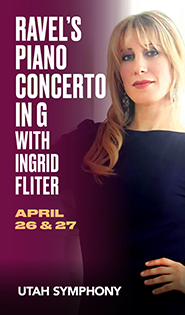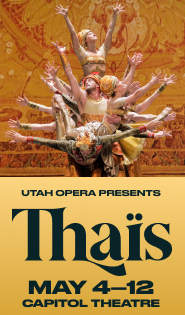Poschner brings variety and vitality to Utah Symphony program
The Utah Symphony concert Friday night under the baton of German conductor Markus Poschner called to mind the interesting programming choices of its recently departed music director, Thierry Fischer. A champion of new music, Fischer also liked to juxtapose pieces in a way that allows audiences to see them in a new light.
Not only did Friday’s program feature the first 21st century piece of this season’s Masterworks series—Mathilde Wantenaar’s Prelude á une nuit américaine – but it also pit the warring factions of German Romanticism against one another with two representative pieces written around the same time: Richard Strauss’s Death and Transfiguration and Johannes Brahms’ Symphony No. 2.
While the programming choices may have been reminiscent of Fischer, Poschner’s conducting style was all his own. The returning guest conductor achieved a distinctive sound from the orchestra, particularly in the strings which displayed a full array of colors, textures, and tones. Tall and trim and wearing an elegant tuxedo, Poschner employed small, precise movements to great effect. In all three pieces, his personality came through in his inventive approach to phrasing a melody and his sense of thematic architecture.
Poschner’s enchanting interpretation of the Wantenaar employed a level of subtlety and sensitivity rarely heard in performances of new works. Wantenaar wrote the piece in 2019, when she was 26, on a commission from the Rotterdam Philharmonic. It has a misty, atmospheric quality like the Debussy piece referenced in its title, but with more of a sense of drama and pathos. Wantenaar’s Prelude also has a more advanced harmonic language than Debussy’s, flirting with 12-tone serialism in a post-modern way, while keeping a sense of harmonic tension and resolution.
Wantenaar’s main theme, repeated more than once, features primordial rumbling in the timpani and low strings which grows into scales and arpeggios throughout the orchestra, building to a climax and then dissipating into a gentle melody on solo trumpet or violin. With clear, conscientious phrasing that made use of every note, Poschner infused the piece with a sense of forward-moving tension, pulling back just enough to give its still, delicate moments a chance to breathe.
Poschner’s interpretation of the Strauss was expansive, capturing both its menace and sweetness and giving life to the unconstrained expression that separated Wagnerians like Strauss from traditionalists like Brahms. It began subtly, maintaining a sense of anticipation and foreboding as the dark, dirge-like beginning gave way to sweeter melodic passages over a gently arpeggiating harp. He gave the piece room to grow until the full orchestra entered the fray and captured the piece’s epic struggle between death and redemption.
The orchestra’s rendition featured glorious sonorities, including in the quiet passages in the low register, which were lucid and clear. Still, at times, the piece seemed disjointed, and the moments disconnected from one another, albeit closing in a strong, climactic finish.
After intermission, Poschner addressed the audience with a few remarks about the Brahams symphony they were about to hear, citing the composer’s humanity and love. The conductor’s affinity for Brahams came through clearly in his nuanced interpretation.
Often compared to Beethoven’s Pastoral Symphony, Brahms’ Second Symphony is his cheeriest. Poschner accentuated its joy and wit while acknowledging the piece’s thematic richness. He gave the first movement a lilting playfulness as well as a transparent texture that allowed the composer’s masterful counterpoint to come through. The second theme develops Brahms’ famous lullaby, and Poschner’s phrasing acknowledged the composer’s inventiveness through its variations and interpolations.
The second movement was stately yet wistful. Witty, well-phrased scalar passages in the strings contrasted with a passionately churning development section. The third movement brimmed with rhythmic vitality, but also displayed an elegant refinement reminiscent of Mozart or Haydn.
Poschner infused the energetic finale with a bustling, celebratory feel, accentuated by an exquisite blend between the strings and the brass. After the triumphant finish, the audience rose to its feet in an enthusiastic ovation that included several curtain calls.
The Utah Symphony will repeat this program 7:30 p.m. Saturday at Abravanel Hall. www.usuo.org



Posted Nov 18, 2023 at 4:50 pm by Moselle Eugen
At this point, conductor Markus Poschner is likely one of the leading candidates to become the new music director of the Utah Symphony. He might even be the odds-on favorite.